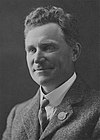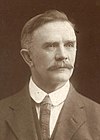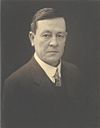First Bruce ministry
First Bruce ministry | |
|---|---|
16th Ministry of Australia | |
 Group photo of the First Bruce ministry | |
| Date formed | 9 February 1923 |
| Date dissolved | 18 December 1925 |
| People and organisations | |
| Monarch | George V |
| Governor-General | Lord Forster Lord Stonehaven |
| Prime Minister | Stanley Bruce |
| No. of ministers | 15 |
| Member party | Nationalist–Country coalition |
| Status in legislature | Coalition majority government |
| Opposition party | Labor |
| Opposition leader | Matthew Charlton |
| History | |
| Election(s) | 16 December 1922 |
| Outgoing election | 14 November 1925 |
| Legislature term(s) | 9th |
| Predecessor | Fifth Hughes ministry |
| Successor | Second Bruce ministry |
The First Bruce ministry (Nationalist–Country Coalition) was the 16th ministry of the Government of Australia. It was led by the country's 8th Prime Minister, Stanley Bruce. The First Bruce ministry succeeded the Fifth Hughes ministry, which dissolved on 9 February 1923 following the December 1922 federal election and the subsequent resignation of Billy Hughes as Prime Minister. The Nationalists had lost their majority in the election, and had no choice but to negotiate a Coalition deal with the Country Party. However, Country leader Earle Page let it be known that no deal could be made unless Hughes resigned. It is the first ministry that consists of a centre-right Coalition between the senior conservative party and the junior rural party - this Coalition has more or less endured to this day with the modern-day Liberal Party and National Party. The ministry was replaced by the Second Bruce ministry on 18 December 1925 following the 1925 federal election.[1]
Stanley Bruce, who died in 1967, was the last surviving member of the First Bruce ministry; Bruce was also the last surviving member of the Fifth Hughes ministry and the Second Bruce ministry. Earle Page was the last surviving Country minister.

Ministry[edit]
| Party | Minister | Portrait | Portfolio | |
|---|---|---|---|---|
| Nationalist | Rt Hon Stanley Bruce MC (1883–1967) |

|
||
| Country | Hon Dr Earle Page (1880–1961) |

|
||
| Nationalist | Hon (Sir) Littleton Groom (KCMG) (KC) (1867–1936) MP for Darling Downs |

|
| |
| Nationalist | Rt Hon George Pearce (1870–1952) Senator for Western Australia |

|
||
| Nationalist | Hon Austin Chapman (1864–1926) MP for Eden-Monaro |

|
| |
| Country | Hon Percy Stewart (1885–1931) |

|
| |
| Nationalist | Hon Eric Bowden (1871–1931) MP for Parramatta |

|
| |
| Country | Hon William Gibson (1869–1955) MP for Corangamite |

|
||
| Country | Hon Llewellyn Atkinson (1867–1945) |

|
||
| Nationalist | Hon Victor Wilson (1877–1957) Senator for South Australia |

|
| |
| Nationalist | Hon Thomas Crawford (1865–1948) Senator for Queensland |

|
| |
| Nationalist | Hon Herbert Pratten (1865–1928) |

|
| |
| Country | Hon William Hill (1866–1939) |

|
| |
| Nationalist | Hon Sir Neville Howse VC KCB KCMG (1863–1930) MP for Calare |

|
| |
| Nationalist | Hon Charles Marr DSO MC (1880–1960) MP for Parkes |

|
| |
References[edit]
- ^ "Ministries and Cabinets". Parliamentary Handbook. Parliament of Australia. Archived from the original on 8 October 2012. Retrieved 17 September 2010.

